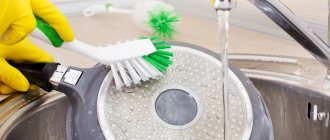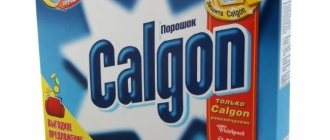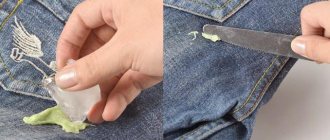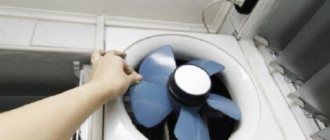Cleaning outside
The best way to clean the outside of a frying pan is to use chemical cleaners. The concentrated product is applied to the surface and left for 15 minutes.
Then the old carbon deposits are washed off with water. To make the cleaning process faster, you can use sprays. If another liquid is used, then when applied to the surface it is thoroughly foamed.
Do not allow chemicals to get on the inside of the container.
Store-bought cleaning products
Store-bought sprays, gels and other cleaning substances may only be used on the outside of cookware.
Rules of use:
- Foam is the fastest-acting remedy. After application to the surface, the contamination dissolves within 15 minutes.
- Gel and cream are thick, highly concentrated substances. They are applied to a dirty surface for 30 minutes.
- The spray is applied to the outside of the product and wait for the time specified in the instructions.
Important! Washing dishes should be thorough after using any cleaning agent.
Cast iron and steel
Dishes made of cast iron and steel can be washed using proven folk remedies. For example, regular table salt will help. You should take half a glass of salt, pour it into a frying pan, level it over the bottom and leave for several hours. If the stains are small, they can be easily washed off with warm water. If there is still burnt food left, you can heat a frying pan with salt on a well-heated stove to enhance the effect. After this procedure, it will wash off quite easily.
Activated carbon is also used to clean cast iron and steel. To do this, coal, produced in tablets, is crushed into powder and sprinkled on “problem” areas. Add a small amount of warm water to the pan. Leave for up to half an hour. Then wash it thoroughly.
Mechanical cleaning methods (hard sponge, wire mesh, scraper) are also successfully used for these materials.
Recommendations for choosing a quality cast iron frying pan with Teflon coating
A cast iron non-stick frying pan is a very important piece of cookware. It is assigned a number of functions, and therefore, when buying it, every housewife wants to receive a practical and convenient product as a result. To prevent your purchase from becoming a disappointment, you need to pay attention to important recommendations.
- The bottom of such a frying pan should be as thick as possible. The same applies to the walls.
- To control the heating level, it is recommended to buy frying pans with a special indicator. It is located at the bottom inside and changes color depending on the temperature.
- It is best to choose frying pans with a very textured bottom. In this case, the more convexity, the better.
- If the bottom is smooth, without relief, then it should be perfectly flat. Pits or bumps indicate defects for which such a product cannot be used.
- When choosing an external coating, it is recommended to give preference to enamel. It is more resistant to mechanical damage (including when trying to clean). Varnish quickly scratches and burns.
- The size of the bottom must correspond to the diameter of the burners. If it is less, the food near the side walls will burn; if it is more, it will remain uncooked.
- The handle is more comfortable and will last longer if it is cast, that is, it is a single whole with the entire frying pan. The material for it should be with low thermal conductivity. This will protect you from burns.
- Before purchasing a cast iron frying pan, you should inspect it carefully. It may be damaged during transportation.
- You should not buy Teflon frying pans in stores without a special license for the product and a certificate of conformity. Such products may be counterfeit and cause harm to health.
How to avoid damaging your frying pan while cleaning?
“Contraindications” are obvious for any type of coating.
- Do not scrape with a knife or sharp objects. This may damage the surface.
- After washing, wipe the pan dry. Otherwise, water leads to oxidation, and rust can render any metal object unusable.
- Avoid temperature changes when washing. Deformation will not take long to occur.
- Do not stack pans on top of each other. Products deteriorate upon contact. If necessary, kitchen utensils are separated with paper, napkins or towels.
We revealed all the secrets of experienced housewives and told us how to remove unwanted “coating” from frying pans. It turns out that any of us can do this! Restoring products does not require expensive cleaning products or special skills. All you need is desire, half an hour to an hour, patience and effort. The result will meet all expectations: the pans will be like new.
Please note: Lawn aerator - what is it: 4 cheat sheets on how to use it
Popular manufacturers of Teflon frying pans
The most famous companies engaged in the production of such tableware delight us with their new products and improved models from year to year. The leading ones among them are the following.
Teflon coating is a convenient invention designed to facilitate the cooking process. However, we should not forget that everything has two sides: positive and negative. When choosing a frying pan with such a non-stick coating, be very careful and careful. And may your kitchen be safe.
Buy dishes with a thermopot (temperature indicator). This way you will save it from the danger of overheating.
Methods for cleaning old fat and dirt using folk remedies
- Simply and easily. The fight against carbon deposits is carried out using soda. You need to fill the frying pan with water with the addition of a few spoons of soda. Place the pan on the fire and bring it to a boil. After waiting for the mixture to boil, remove it from the stove. Once the water has cooled, pour it out and rinse the pan thoroughly.
- A similar method, but even more effective. You need to fill the frying pan with water and add a packet of citric acid. Place the dishes on the fire and bring to a boil. After this, leave to stand until completely cool. The acid will do the cleaning job. The housewife will only have to drain the water and rinse the pan.
- Original, unusual and very effective! Take a fresh apple, cut off the skin and cut the pulp with a knife so that the juice comes out of it. The juicy pulp should be distributed over the entire surface of the frying pan. Leave for fifteen or twenty minutes. After this, use a soft sponge to very carefully remove the product, cleaning the dishes.
How to clean rust from a frying pan
Method number 1: using salt and paper
Sodium chloride acts like sandpaper, helping to remove rust without damaging the cookware. Pour a thin layer of salt into the pan and wipe the pan with paper. Throw away the red salt, fill the bottom with fresh salt and repeat these steps until the rust is removed.
Method number 2: steel wool
It will work if there is a thin layer of rust on the surface. When cleaning, add a couple of drops of dishwashing detergent. This will prevent scratches on the product.
Method number 3: potatoes and baking soda
The starchy vegetable is cut in half and rolled in soda. Rub the rusty area with the cut side, then rinse and repeat until the red-brown spots completely disappear.
Method No. 4: acid solution
To soften the rust, you need to soak the kitchen utensil overnight in an acid-containing chemical, and then remove the residue with a sponge. You can add 1-2 tablespoons of salt for better results.
Method number 5: peroxide + soda
Baking soda combined with hydrogen peroxide has long become a universal tool for cleaning any surface. When cleaning kitchen utensils, it effectively removes both old and recent rust.
Mix a bottle of peroxide and a pack of baking soda. Heat a frying pan and apply the resulting paste for half an hour. Then scrub vigorously with the brush and rinse with water.
Educational article: How to flip the screen on a laptop or desktop computer? — 3 methods
Is it possible to restore the non-stick coating on a frying pan at home?
Another obvious solution to the problem is to try to apply a new non-stick coating yourself to replace the damaged one.
You must understand that it is simply impossible to do this efficiently at home. Applying a non-stick layer is a complex process. A composition consisting of several components is applied to the prepared surface. This is often done under high pressure. Then you need to wait for the layer to dry. Drying does not take place at room temperature, but in special chambers. Finding materials and following the technology for applying a non-stick layer at home is unrealistic.
If you wish, you can contact companies that specialize in restoring damaged non-stick coatings. But often it will be cheaper to buy a new frying pan than to repair an old one.
Therefore, if scratches, chips appear on the non-stick layer, and food begins to burn, it is better to seriously think about buying a new frying pan. And in order to extend its service life, you must follow all the manufacturer’s recommendations for its operation.
Which coating is better, Teflon or ceramic?
Ceramic, along with Teflon, is one of the most popular non-stick coatings. To figure out which one is better, let's look at the pros and cons of the first.
Advantages of ceramic coating:
- Withstands very high temperatures - about 450 degrees.
- More resistant to mechanical damage than Teflon.
- During the cooking process, you can use a small amount of oil (only the necessary minimum).
- Easy to clean.
- Does not release carcinogenic substances when heated.
The size of the bottom layer affects the strength of the pan when heated. The thicker the bottom, the lower the risk of deformation of the pan.
Disadvantages of ceramic coating:
- Afraid of too strong temperature changes (a hot frying pan under cold water).
- You cannot use metal utensils, only wood, plastic, and silicone.
- You should not soak such products for a long time. It's better to wash immediately.
The lightest models, as a rule, are not durable and strong, and deformation of the coating can be relatively rapid.
Based on the characteristics of the ceramic coating, we can conclude that it is an environmentally friendly alternative to Teflon, while having all its positive characteristics.
How to wash a Teflon multicooker bowl
To prevent food from burning, you need to regularly clean the multicooker pan using soft sponges and delicate detergents. After manual cleaning, many manufacturers advise placing a lemon cut into several pieces inside the device and activating the “Steam” program for 10 minutes. This will help in getting rid of the unpleasant odor.
There is another simple method:
- The multicooker bowl is filled with 0.5 liters of water, 100 ml of 9% vinegar is added and the “Stew” mode is turned on for 20 minutes;
- The fat is removed with a soft sponge along with any remaining product. Frozen stains are removed with a wooden spatula;
- Finally, wipe the surface of the bowl dry with a cloth.
What are the advantages and disadvantages of Teflon frying pans?
Any material combines positive and negative qualities. On the one hand, it is simply irreplaceable, but on the other, it requires special care or handling skills. This also applies to such a common material for non-stick coating of frying pans as Teflon.
Teflon frying pans have an important advantage - they are lighter in weight than ceramic ones and, of course, lighter than cast iron ones.
Let's look at them in more detail.
- Teflon-coated pans heat up quite quickly. This makes the cooking process more convenient and not very time-consuming.
- Teflon coating prevents the proliferation of pathogenic organisms.
- Cooking with them is also convenient because you don’t need to use a lot of oil. You just need to lightly grease the pan with a whisk, or you can do without it at all. Such food, moreover, becomes more healthy and low-calorie.
- Teflon-coated pans are easy to clean, because food does not stick and can be removed with a soft sponge without much effort.
- These dishes are light in weight. Lightness makes it more convenient to use.
- Teflon pans are quite durable, provided that the non-stick coating is not damaged.
Modern chemicals
What household chemicals can be used to remove carbon deposits from frying pans made of various materials? Most strong products designed for cleaning stoves and ovens will work. They will help overcome soot and grease in the frying pan. These tools are recognized by their names. They are called "grease removers", "plaque removers" and "anti-grease". Use them strictly according to the instructions. These agents are very aggressive. After cleaning with household chemicals, the frying pan is rinsed with plenty of warm water.
How to clean a frying pan outside and inside: 6 tips and life hacks for different pans
In order for the pans to serve you for a long time and not overshadow the cooking process, they need to be cleaned of dirt in a timely manner. However, different frying pans require different care.
To make household chores a joy, dress nicely and comfortably at home! Pay attention to the patterns of home dresses, home trousers and home tops in our electronic catalog.
Before cleaning the inside of a frying pan, you must first determine whether it has a non-stick coating and what material the frying pan is made of. What will benefit a cast iron frying pan can irreparably damage, for example, a Teflon-coated frying pan.
How to clean the inside of a frying pan with a Teflon non-stick coating
As a rule, pans with a non-stick coating do not get too dirty from the inside - precisely because of this coating. But if this does happen, boil water and soda in a frying pan. Pour water into a frying pan, add a couple of tablespoons of soda and put on fire. Wait for it to boil and simmer over low heat for a few minutes, then turn off the heat and leave until cool. Then pour out the water and wash the pan with water and a soft sponge.
Another way: fill the frying pan with hot water and detergent and let it sit. Then wash with a foam sponge. You can also use laundry soap.
How not to wash Teflon pans:
In general, you should handle the non-stick Teflon coating as carefully as possible: do not rub it with the hard side of a sponge, metal mesh, abrasive detergents, do not use metal spatulas, do not ignite it: all this can damage the coating.
Temperature changes also have a negative impact on the coating. That is, do not place a frying pan that has recently been removed from the heat under cool or cold water, but let it cool.
How to clean quickly and efficiently: 2 life hacks from professionals
How to clean the inside of a ceramic-coated frying pan
Ceramic coating is more resistant than Teflon, but you should not use too aggressive agents when washing such pans, so as not to damage it.
If there is dirt on the frying pan that is difficult to clean, try soaking the frying pan by pouring water and detergent into it.
Fresh dirt can be removed from a hot frying pan by rubbing it with a napkin or cloth moistened with vegetable oil.
You can remove dirt from a cooled pan by wiping it with a cloth moistened with alcohol.
You can also use a solution of oven cleaner. In general, such agents may differ in concentration and aggressiveness of impact. Therefore, it is better to test on a small area from the edge of the wall of the frying pan. But before that, be sure to dilute the product in water in a ratio of 1/20.
How not to wash ceramic pans:
They cannot be washed with soda and other abrasive cleaning agents, hard sponges and metal meshes, or melamine sponges. It is better not to use the boiling soda method for such pans. They also cannot be heated. Avoid temperature changes: do not place a hot frying pan under cold water.
Idea: Double-sided, reusable cleaning wipes
How to clean the inside of an aluminum frying pan
Aluminum frying pans are easier to maintain, but carbon deposits form on them more often than on Teflon or ceramic ones.
The easiest way to clean the inside of a pan is to try boiling it with baking soda. Pour water into the pan and add baking soda - the more, the more dirty it is. Bring the water to a boil and simmer over low heat for several minutes. Leave until cool and try washing the pan. You can use hard plastic brushes and the abrasive side of a sponge. It happens that not all contaminants are removed the first time. Then after washing, repeat the boiling process.
How not to wash aluminum cookware:
Products that contain chlorine or aggressive alkali can change the color of the dishes; it is better not to use them. Also, do not wash such pans with metal brushes, meshes or other too hard devices that can scratch the aluminum. Scratches, even small ones, will cause the food to burn more.
Wool laundry balls: why are they needed and how to make them
How to clean the inside of a cast iron frying pan
To prevent food from sticking to the frying pan when using it, it must be heated before first use.
To do this, wash the pan thoroughly and dry it. Sprinkle a thick layer of salt on the bottom and place on the fire. Heat the pan over low heat for an hour, stirring the salt occasionally. Then turn off the heat, wait for the pan to cool and pour in the salt. Wipe the pan thoroughly with a cloth to remove any remaining salt. Rub vegetable oil into the pan using a napkin. Then heat the pan and cool.
Then, after each cooking session, wipe down the pan with oil.
If contaminants still form inside, try boiling with soda, described above.
In the case of a cast iron frying pan, you can also add a couple of tablespoons of salt and a little table vinegar to the boiling water.
If the dirt is very strong, you can heat the pan in the oven using the oven's self-cleaning function. After this, let the pan cool and wash it. Then dry and wipe with vegetable oil, heat and cool.
You can also wash the frying pan with salt paste: pour a couple of tablespoons of salt into it, mix with a little water and rub using a sponge. Then wash the frying pan, wipe dry, grease with oil and heat.
What not to wash cast iron pans:
Do not use anything too hard, such as a metal mesh, to avoid scratching the surface. Do not leave water in the pan for a long time to prevent rust. For the same reason, it is better to immediately wipe the frying pan after washing and do not store it where water may get on it.
Why can natural silk be washed with hair shampoo?
Can pans be washed in the dishwasher?
It is best not to wash Teflon-coated pans, aluminum pans or cast iron pans in the dishwasher. Most often, it is not recommended to wash frying pans with a ceramic coating in it either. But it happens that the manufacturer indicates that this is possible for different frying pans, then follow his instructions. For example, some pans can be washed in the dishwasher on a delicate cycle.
How to properly wash brushes and hair combs: 6 tips and life hacks
How to clean the carbon deposits from the outside of a frying pan?
You can wash off the carbon deposits that form on the outside of the frying pan in different ways.
If you don't mind the possibility of scratches, use hard brushes and metal mesh. Before doing this, you can soak the frying pan in hot water with dissolved soda. Leave the pan in the solution for at least 20 minutes, then try to remove the stains mechanically. Repeat until you are satisfied with the result.
Another way: mix salt, baking soda and dish soap and coat the outside of the pan with the mixture, turning it over before doing so. Cover the pan with paper towels and pour vinegar on top. Leave it for a while. Remove the wipes; most of the dirt should be easily removed.
Uncoated aluminum and cast iron frying pans can be baked in the oven. Do not use this method for pans with wooden or plastic handles. Place the pan in the oven and turn on the self-cleaning mode or set the temperature to high, close the door and leave the pan to bake for 1-2 hours. The dirt will simply burn off, and what remains will be easy to wash.
You can also use grease and carbon removers to clean the outside of frying pans. Proceed according to the instructions: apply the product, leave for the required time, rinse. When doing this, make sure that the product does not get on the inside of the pan.
How to wash black clothes correctly
Photo: hssuk.co.uk, Tramontina, apartmenttherapy.com, thespruce.com, panelux.com.br, seriouseats.com











